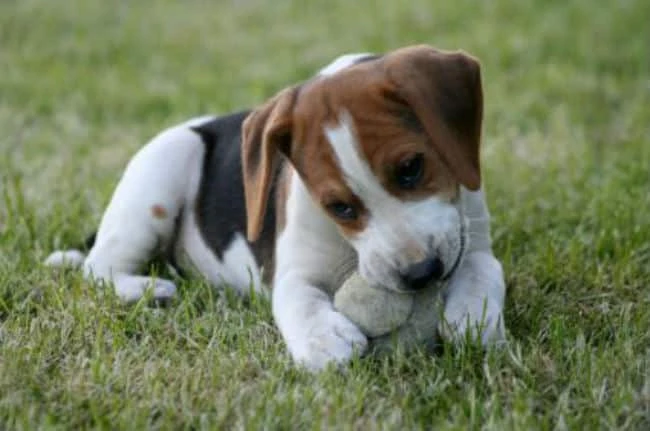The Dog Owners Guide to Puppy Teeth

If you want to know about puppy teeth then you are in the right place. Puppies are normally always born without teeth with the Incisors being the first teeth to develop (these normally start to grow when the puppy has reached two to three weeks of age).
The canines and premolars are the next puppy teeth to develop (the last premolar will normally start to show as the puppy gets to about eight to twelve weeks of age). It is also worth mentioning that the teeth in larger breeds normally start to appear sooner than teeth in smaller breeds.
Adult dogs will normally have a total of forty two teeth – however young puppies will only have twenty eight deciduous puppy teeth (this just means that that they are temporary). Interestingly young puppies do not have molars (as seen in adults). Puppy teeth consist of incisors, canines and premolars.
The temporary or deciduous teeth will normally stay in place for approximately three up to seven months and from the age of three months the baby incisors are replaced with adult incisors. By the time the puppy reaches the age of five months all of their adult incisors should have developed.
Between the age of four and seven months the puppy should have developed adult canines, premolars and molars. So by the age of seven to eight months of age a puppy should have all of their adult teeth in place.
It is actually possible for a vet (and owner) to tell the age of a dog or puppy by examining their teeth and well they have been worn down.
Doggie Teeth And Age
To determine how old your dog is a vet can look at the wear and tear of the incisors. Although this is only an approximation and is not 100% accurate a vet can use this method with some accuracy up to the age of six (after the age of six it is very difficult to get any accurate determination of age).
To determine the age of a dog or puppy through this method the vet will examine the ‘cusps’ of each tooth (the cusps are the edges of the incisors). As the cusps start to wear down the vet can determine how the wear of each tooth relates to the age of the dog or puppy (see the cusp chart below).
1 year of age – The cusps are worn off from the lower incisors and tartar will begin to show on the canines.
2 years of age – The cusps are worn off from the lower incisors and tartar is even more noticeable on the canines.
3 years of age – The cusps are worn off from the upper incisors.
4 years of age – The cusps are worn off from the upper incisors.
5 years of age – At this age the cusps will start to wear down slightly on the corner of the lower incisors (at this stage the canines will also start to show some wear).
6 years of age – At this age the cusps will have worn off from the lower incisors (the canines will now have become blunt).
What Puppy Teeth Become Adult Dog Teeth
Puppy teeth are normally reabsorbed by the puppy as the adult teeth start to grow and develop. However in some cases the puppy teeth will stay in place as the adult teeth grow – this will cause the baby teeth to push against the new teeth causing problems in their alignment – this problem can also cause a bad bite or malocclusion. This problem seems to be more common in toy breeds.
It is very important that puppies between the age of three and four months are checked on a regular basis to make sure that the adult teeth are developing properly. If there are problems with their development i.e. the baby teeth are causing issues with the new adult teeth then they should be extracted – ideally this should be performed by the age of four and five months to make sure that there is no on-going problem with the puppy’s bite.
About Puppy Teething
As previously mentioned during the period of teething puppies should have their teeth and mouths checked on a weekly basis. It is always a good idea during the teething process for owners to ‘play’ with the puppy’s mouth (pulling the lips away from the mouth and gently rubbing the gums). However, during this process it is very important that you do not touch the puppy’s very sensitive noses.
When you have your fingers in the puppy’s mouth it is very important that the puppy does not chew on your fingers. So praise your puppy when you are examining the mouth and give them a treat afterwards as this will enable you to check the teeth again.
It is not uncommon for a puppy’s teeth to bleed during the teething process. The teething process can be painful so if your puppy is teething then they may become apathetic, whine or even experience diarrhea. The process can be smooth or difficult it really depends on each individual puppy – however one thing that is very important for a teething puppy is to have chews available so they are able to chew and alleviate some of their need to relieve the issues associated with teething.
How To Get Your Puppy To Stop Biting
Dog Health Problems Online > Guide to Adult Dog Teeth > Puppy Teeth





